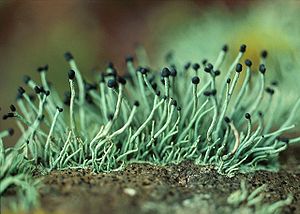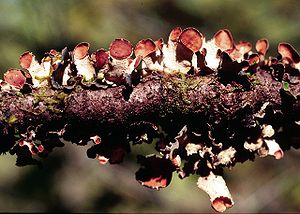Lichens: Difference between revisions
| Line 4: | Line 4: | ||
[[Image:Pilophorus_acicularis.jpg|thumb||300px||right|Fruticose lichen photograph by OSU Lichen Group,1999. Photographs of Pacific Northwest Lichens. Oregon State University, Department of Botany and Plant Pathology, Lichen Research Group.]] | [[Image:Pilophorus_acicularis.jpg|thumb||300px||right|Fruticose lichen: photograph by OSU Lichen Group,1999. Photographs of Pacific Northwest Lichens. Oregon State University, Department of Botany and Plant Pathology, Lichen Research Group.]] | ||
[[Image:Nephroma_bellum.jpg|thumb||300px||right|Foliose lichen photograph by OSU Lichen Group,1999. Photographs of Pacific Northwest Lichens. Oregon State University, Department of Botany and Plant Pathology, Lichen Research Group.]] | [[Image:Nephroma_bellum.jpg|thumb||300px||right|Foliose lichen: photograph by OSU Lichen Group,1999. Photographs of Pacific Northwest Lichens. Oregon State University, Department of Botany and Plant Pathology, Lichen Research Group.]] | ||
Revision as of 20:01, 30 March 2010
Introduction
Lichens are a form of symbiotic association of fungi and algae. Lichens can also be formed by symbiotic association between fungi and cyanobacteria. The algal or cyanobacterial cells carry out photosynthesis and provide nutrients for fungus. The fungal partener in turn helps algae with improved water uptake and also helps to survive under extremely unfavorable environmental conditions as a unit. Lichens play a significant ecological role as it can colonize barren earth and rock and make the harsh environment to a fertile one where other organisms can start establishing themselves [1].For example, in recent years, researchers have identified lichen as old as 600 million years through analysis of fossil and phylogenetic data [2]. in addition, some species of lichens inhabiting forests are important in providing food and shelter for birds and animals [3]. Further, lichens are being used as ecological indicators of pollution.
Other examples:
Bold
Italic
Subscript: H2O
Superscript: Fe3+
Other examples:
Bold
Italic
Subscript: H2O
Superscript: Fe3+
This template gives you a general idea of the layout of your page. You are not completely restricted to this format, so feel free to try out different things. I'll give you feedback as you work on your pages. Make sure to copy the "code" of this page to your own page before editing. -Prof Kent
In the introduction, briefly describe the habitat that is the topic of this page. Introduce the habitat, its ecological significance, and the importance of microorganisms in this environment. (What processes do they carry out? What functions do they perform?)
Physical environment
Describe the physical and chemical characteristics of the environment, using as many sections/subsections as you require. Look at other topics available in MicrobeWiki. Which involve processes similar to yours? Create links where relevant.
Subsection 1
Subsection 1a
Subsection 1b
Subsection 2
Biological interactions
Are there important biological interactions that are important in this environment? Do these interactions influence microbial populations and their activities? How do these interactions influence other organisms? Describe biological interactions that might take place in this environment, using as many sections/subsections as you require. Look at other topics available in MicrobeWiki. Create links where relevant.
Subsection 1
Subsection 1a
Subsection 1b
Subsection 2
Microbial processes
What microbial processes define this environment? Describe microbial processes that are important in this habitat, adding sections/subsections as needed. Look at other topics in MicrobeWiki. Are some of these processes already described? Create links where relevant.
Subsection 1
Subsection 1a
Subsection 1b
Subsection 2
Key Microorganisms
What kind of microbes do we typically find in this environment? Or associated with important processes in this environment? Describe key groups of microbes that we find in this environment, and any special adaptations they may have evolved to survive in this environment. Add sections/subsections as needed. Look at other microbe listings in MicrobeWiki. Are some of the groups of microbes from your environment already described? Create links to those pages. Specific microbial populations will be included in the next section.
Subsection 1
Subsection 1a
Subsection 1b
Subsection 2
Examples of organisms within the group
List examples of specific microbes that represent key groups or are associated with important processes found in this environment. Link to other MicrobeWiki pages where possible.
Current Research
Enter summaries of recent research here--at least three required
References
Edited by student of Angela Kent at the University of Illinois at Urbana-Champaign.


